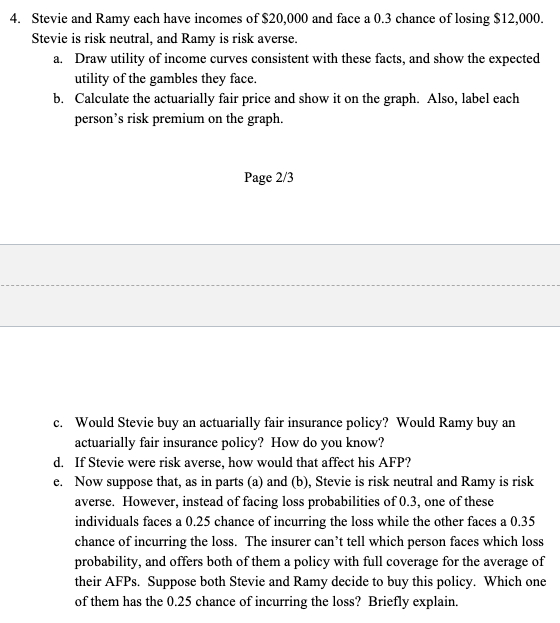
4. Stevie and Ramy each have incomes of $20,000 and face a 0.3 chance of losing $12,000. Stevie is risk neutral, and Ramy is risk averse. a. Draw utility of income curves consistent with these facts, and show the expected utility of the gambles they face. b. Calculate the actuarially fair price and show it on the graph. Also, label each person's risk premium on the graph. Page 2/3 c. Would Stevie buy an actuarially fair insurance policy? Would Ramy buy an actuarially fair insurance policy? How do you know? d. If Stevie were risk averse, how would that affect his AFP? e. Now suppose that, as in parts (a) and (b), Stevie is risk neutral and Ramy is risk averse. However, instead of facing loss probabilities of 0.3, one of these individuals faces a 0.25 chance of incurring the loss while the other faces a 0.35 chance of incurring the loss. The insurer can't tell which person faces which loss probability, and offers both of them a policy with full coverage for the average of their AFPs. Suppose both Stevie and Ramy decide to buy this policy. Which one of them has the 0.25 chance of incurring the loss? Briefly explain. 4. Stevie and Ramy each have incomes of $20,000 and face a 0.3 chance of losing $12,000. Stevie is risk neutral, and Ramy is risk averse. a. Draw utility of income curves consistent with these facts, and show the expected utility of the gambles they face. b. Calculate the actuarially fair price and show it on the graph. Also, label each person's risk premium on the graph. Page 2/3 c. Would Stevie buy an actuarially fair insurance policy? Would Ramy buy an actuarially fair insurance policy? How do you know? d. If Stevie were risk averse, how would that affect his AFP? e. Now suppose that, as in parts (a) and (b), Stevie is risk neutral and Ramy is risk averse. However, instead of facing loss probabilities of 0.3, one of these individuals faces a 0.25 chance of incurring the loss while the other faces a 0.35 chance of incurring the loss. The insurer can't tell which person faces which loss probability, and offers both of them a policy with full coverage for the average of their AFPs. Suppose both Stevie and Ramy decide to buy this policy. Which one of them has the 0.25 chance of incurring the loss? Briefly explain







